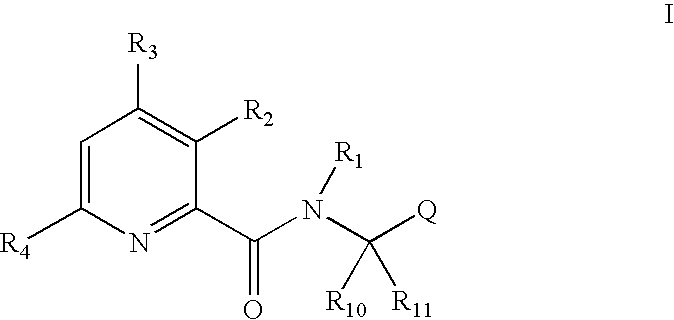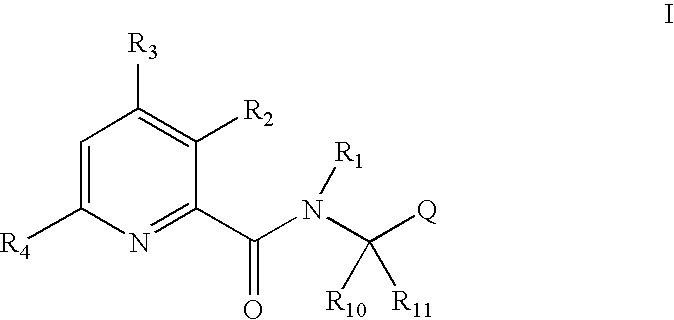Pyridine carboxamide and methods for inhibiting HIV integrase
a technology of pyridine carboxamide and hiv integrase, which is applied in the field of compounds, can solve the problems of lack of inhibitory potency and potential cytotoxicity, and achieve the effect of preventing the integration of hiv dna
- Summary
- Abstract
- Description
- Claims
- Application Information
AI Technical Summary
Benefits of technology
Problems solved by technology
Method used
Image
Examples
example 1
3-Hydroxy-[2,4′]bipyridinyl-2′-carboxylic acid 4-fluoro-benzylamide compound 1
Step I
4-Chloro-pyridine-2-carboxylic acid 4-fluoro-benzylamide
[0330] To a solution of picolinic acid (1 g, 8.12 mmol) in thionyl chloride (3 ml) at 45° C. under nitrogen, was added DMF (100 μl) The solution was stirred overnight. Then thionyl chloride was evaporated and co-evaporated with toluene twice. The residue was dissolved into anhydrous CH2Cl2 (10 ml), and to the solution was introduced 4-fluorobenzylamine (2.6 g in CH2Cl2) slowly at 0° C. The mixture was stirred at room temperature for 3 h. After removal of the solvent under reduced pressure, a brownish solid was obtained. This crude mixture was subjected to silica gel column chromatography eluting with hexane:ethyl acetate (4:1) to afford the desired product in a yield of 1 g.
[0331]1H NMR (400 MHz, CDCl3): δ [ppm] 8.41 (d, 1H), 8.27 (br s, 1H), 8.21 (s, 1H), 7.42 (d, 1H), 7.31 (m, 2H), 7.00 (m, 2H), 4.61 (d, 2H).
[0332] LC / MS: m / z 265.1 (M+H+...
example 2
6-Bromo-3,4-dihydroxy-pyridine-2-carboxylic acid 4-fluorobenzylamide compound 7
Step I
3-Benzyloxy-6-bromo-4-methoxy-pyridine-2-carboxylic acid 4-fluorobenzylamide
[0347] Starting from the known 3-benzyloxy-4,6-dibromo-pyridine-2-carboxylic methyl ester, compound 3-benzyloxy-6-bromo-4-methoxy-pyridine-2-carboxylic acid was prepared using a procedure described in Ricks, M. J. et al. WO 01 / 05769 A2. To a solution of this free acid (410 mg, 1.21 mmol) in DMF (910 ml) were added 4-fluorobenzylamine (210 μl, 1.81 mmol), DIPEA (316 μl, 1.81 mmol), and HATU (691 mg, 1.81 mmol). The reaction mixture was stirred at rt for 12 h. Then it was diluted with ether (100 ml) and washed with water (2×50 ml). The organic layer was dried over anhydrous sodium sulfate, filtered and evaporated. The residue was subjected to flash chromatography using hexane and ethyl acetate (6:4) to provide 450 mg of the title compound as white solid.
Step II
6-Bromo-3,4-dihydroxy-pyridine-2-carboxylic acid 4-fluoroben...
example 3
3-Hydroxy-4-methoxy-pyridine-2-carboxylic acid 4-fluorobenzyl-amide compound 9
[0359]
[0360] 3-benzyloxy-4-methoxy-6-bromo-pyridine-2-carboxylic acid 4-fluorobenzylamide was dissolved into a mixture of methanol and ethyl acetate. To the solution was added a catalytic amount of 10% Pd—C. The flask was attached to a hydrogen balloon and the reaction was run at rt for 1 hr. The mixture was filtered through a pad of celite. Removal of the solvent under reduced pressure afforded the desired compound.
[0361]1H NMR (400 MHz, CDCl3): δ [ppm] 12.44 (s, 1H), 8.80 (br s, 1H), 8.16 (d, 1H), 7.40 (m, 2H), 7.17 (d, 1H), 7.10 (m, 2H), 4.61 (d, 2H), 4.11 (s, 3H).
[0362] LC / MS: m / z 277.0 (M+H+).
PUM
| Property | Measurement | Unit |
|---|---|---|
| Fraction | aaaaa | aaaaa |
| Composition | aaaaa | aaaaa |
| Antimicrobial properties | aaaaa | aaaaa |
Abstract
Description
Claims
Application Information
 Login to View More
Login to View More - R&D
- Intellectual Property
- Life Sciences
- Materials
- Tech Scout
- Unparalleled Data Quality
- Higher Quality Content
- 60% Fewer Hallucinations
Browse by: Latest US Patents, China's latest patents, Technical Efficacy Thesaurus, Application Domain, Technology Topic, Popular Technical Reports.
© 2025 PatSnap. All rights reserved.Legal|Privacy policy|Modern Slavery Act Transparency Statement|Sitemap|About US| Contact US: help@patsnap.com



